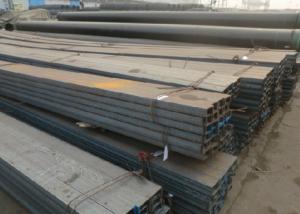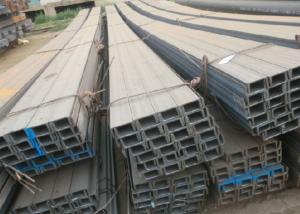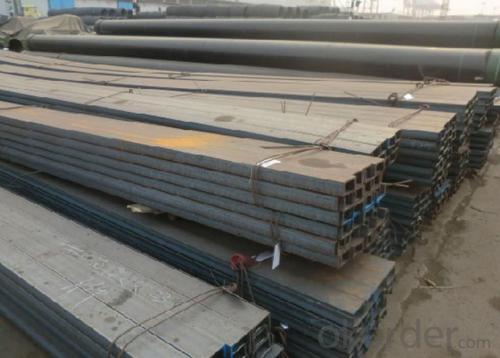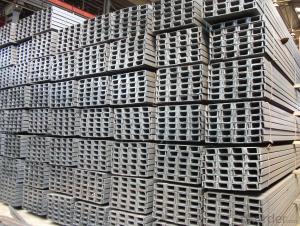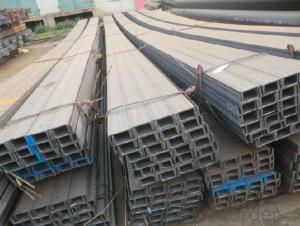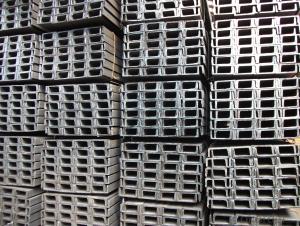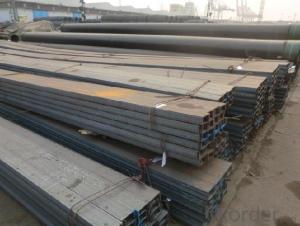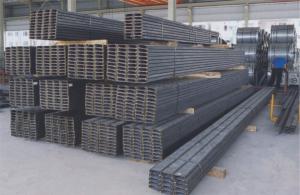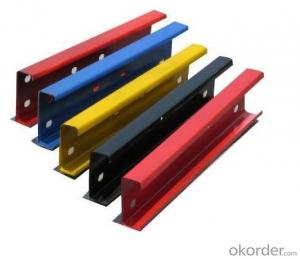MS Channel
- Loading Port:
- Xingang Port
- Payment Terms:
- TT or LC
- Min Order Qty:
- 25MT m.t.
- Supply Capability:
- 5000MT/Month m.t./month
OKorder Service Pledge
OKorder Financial Service
You Might Also Like
Specifications of MS Channel:
1.We supply high quality MS Channel at reasonable price, including Chinese standard, Japanese standard and so on.
Standard | GB/JIS |
Material Grade | Q235,SS400 |
Technique: | Hot Rolled |
Sizes as per chinese standard: | 50*37*4.5mm - 300*89*11.5mm
|
Sizes as per japanese standard: | 50*25*3mm – 200*80*7.5mm |
Length: | 6meter, 9meter, 12meter |
Note: 1.we are also competent to provide our customers other MS Channel based on other sizes according to customer’s requirements.
2. The length of our ms channel could be cut into other meters as per customer’s requirements. For example, the channel in 6meters could be cut into 5.8meters in order to be fit in the 20ft container.
2. The detailed sections of MS Channel as per GB standard.are shown in the table-1:
GB U CHANNEL | Standard | Sectional | Dimension |
| Mass: |
| (mm) | (mm) | (mm) | (mm) |
|
50X37 | 50 | 37 | 4.50 | 7.0 | 5.438 |
63X40 | 63 | 40 | 4.80 | 7.5 | 6.634 |
80x43 | 80 | 43 | 5.00 | 8.0 | 8.045 |
|
|
|
|
|
|
100x48 | 100 | 48 | 5.30 | 8.5 | 10.007 |
120x53 | 120 | 53 | 5.50 | 9.0 | 12.059 |
140x58 | 140 | 58 | 6.00 | 9.5 | 14.535 |
140x60 | 140 | 60 | 8.00 | 9.5 | 16.733 |
|
|
|
|
|
|
160x63 | 160 | 63 | 6.50 | 10.0 | 17.240 |
160x65 | 160 | 65 | 8.50 | 10.0 | 19.752 |
|
|
|
|
|
|
180x68 | 180 | 68 | 7.00 | 10.5 | 20.174 |
180x70 | 180 | 70 | 9.00 | 10.5 | 23.000 |
|
|
|
|
|
|
200x73 | 200 | 73 | 7.00 | 11.0 | 22.637 |
200x75 | 200 | 75 | 9.00 | 11.0 | 25.777 |
|
|
|
|
|
|
220x77 | 220 | 77 | 7.00 | 11.5 | 24.999 |
220x79 | 220 | 79 | 9.00 | 11.5 | 28.453 |
|
|
|
|
|
|
250x78 | 250 | 78 | 7.00 | 12.0 | 27.410 |
250x80 | 250 | 80 | 9.00 | 12.0 | 31.335 |
250x82 | 250 | 82 | 11.00 | 12.0 | 35.260 |
|
|
|
|
| |
280x82 | 280 | 82 | 7.50 | 12.5 | 31.427 |
280x84 | 280 | 84 | 9.50 | 12.5 | 35.823 |
280x86 | 280 | 86 | 11.50 | 12.5 | 40.219 |
|
|
|
|
|
|
300x85 | 300 | 85 | 7.50 | 13.5 | 34.463 |
300x87 | 300 | 87 | 9.50 | 13.5 | 39.173 |
300x89 | 300 | 89 | 11.50 | 13.5 | 43.883 |
Table-1
3. The chemical composition of HR Channel Steel according to Q235B is shown in Table-2.
Alloy No | Grade | Element(%) | ||||
C | Mn | S | P | Si | ||
Q235 | B | 0.12-0.20 | 0.3-0.7 | ≦0.045 | ≦0.045 | ≦0.3 |
Table-2
Note: we are able to present our customers relevant SGS test report for chemical composition of HR Channel Steel.
4. The mechanical property of HR Channel Steel according to Q235B is shown in Table-3-1 and Table-3-2
Alloy No | Grade | Yielding Strength Point(Mpa) | |||
Thickness(mm) | |||||
≦16 | >16-40 | >40-60 | >60-100 | ||
≧ | |||||
Q235 | B | 235 | 225 | 215 | 205 |
Table-3-1
Alloy No | Grade | Tensile Strength(Mpa) | Elongation After Fracture(%) | |||
Thickness(mm) | ||||||
≦16 | >16-40 | >40-60 | >60-100 | |||
≧ | ||||||
G235 | B | 375-500 | 26 | 25 | 24 | 23 |
Table-3-2
Note: we are able to present our customers relevant SGS test report for mechanical property of MS Channel as customer’s request.
Applications of MS Channel:
The MS Channel can be applied to construction of warehouses, workshops, sport stadiums and car parks etc.The hot rolled channel steel belongs to carbon structural steel which is applied to in the field of construction and machinery.In details, the hot rolled channel steel is usually used for arch-itechtural structure, and they could be welded in order to support or hang a vari-ety of facilities. They are also usually used in combination with I beam. Generally,the hot rolled channel steel we supply must possess perfect welding property, riveting property and mechanical property and so on.
Package & Delivery of MS Channel:
1.The hot rolled channel steel will be packed in bundle with steel wire at each end of every bundle and color marking in order to help the customer to recognize his goods more easily at sight.
2. And the hot rolled channel steel could be loaded into 20ft or 40ft container, or by bulk cargo.If the weight of each bundle reaches more than 3.5 mt, the loading by break bulk cargo should be choosed.When the weight of each bundle reaches less than 3mt, the loading by container should be choosed.
3.As for the transportaion from mill to loading port, the truck will be usually used. And the maximum quantity for each truck is 40mt.
4.All in all, we could do in accordance with customer's request.
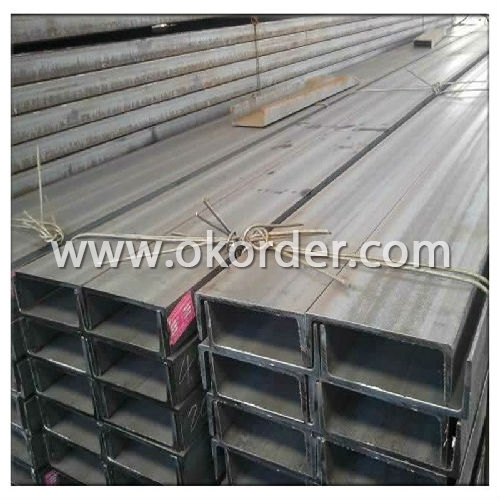
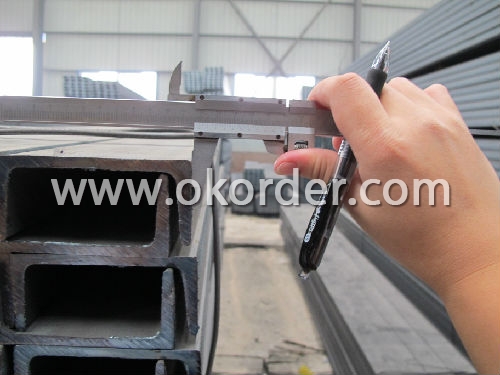
Production Flow of MS Channel:
1.The steel billet shall be heated in the high temperature furnace.
2. The heated steel billet shall be rolled five to nine times with the aim of shaping the general figure of steel u channel.
3. The hot rolled channel steel should be put onto the cooling bed to make the temperature low.
4. The channel steel should be straighted on the straightener.
5. The straighted channel steel will be cut into meters by saw, as per customer's requirements.
- Q: Can steel channels be used in commercial construction?
- Yes, steel channels can be used in commercial construction. Steel channels provide structural support and are commonly used in framing systems, roof trusses, and as structural elements in walls and floors. They are versatile, durable, and offer excellent load-bearing capabilities, making them suitable for various commercial building applications.
- Q: What are the different installation techniques for steel channels?
- Steel channels can be installed in various ways, depending on their intended use and specific requirements. Here are a few commonly used techniques: 1. Welding: By utilizing a welding machine, the steel channels can be fused to the supporting structure, creating a sturdy connection between the two. 2. Bolting: An alternative method involves securing the steel channels to the supporting structure using bolts. This technique is particularly useful when adjustability or removal of the channels is necessary. 3. Adhesive bonding: In certain cases, steel channels can be installed by bonding them to the supporting structure using a strong adhesive. This method is suitable when welding or bolting is not feasible. 4. Mechanical fasteners: For lighter-duty applications or temporary installations, mechanical fasteners like screws, nails, or rivets can be used to affix the steel channels. 5. Sliding or sliding-fit installation: In specific scenarios, steel channels can be easily installed by sliding them into pre-formed slots or grooves in the supporting structure. This facilitates effortless installation and removal as required. When selecting the appropriate installation technique for steel channels, it is crucial to consider the project's specific requirements, such as load-bearing capacity, durability, and ease of installation. Seeking guidance from a structural engineer or construction professional is advisable to ensure the proper installation method is chosen for the particular application.
- Q: Are steel channels suitable for railway infrastructure?
- Yes, steel channels are suitable for railway infrastructure. They provide excellent strength and durability, making them ideal for supporting heavy loads and withstanding the wear and tear of train operations. Steel channels also offer flexibility in design and can be easily fabricated to meet specific railway requirements. Additionally, steel's resistance to corrosion and its low maintenance needs make it a cost-effective choice for long-term railway infrastructure projects.
- Q: How do steel channels perform in terms of wind resistance?
- Steel channels perform very well in terms of wind resistance. Their structural design and material strength allow them to withstand high wind loads without significant deformation or failure. This makes steel channels a reliable choice for applications where wind resistance is a critical factor, such as in the construction of high-rise buildings, bridges, or wind turbine towers.
- Q: Can steel channels be used for staircases?
- Yes, steel channels can be used for staircases. Steel channels are often used as stringers, which are the structural supports for stairs. They provide strength, durability, and stability to the staircase, making them a popular choice in modern architectural designs.
- Q: Are steel channels compatible with other building materials?
- Yes, steel channels are compatible with other building materials. Steel channels are often used in construction projects as structural support elements, and they can be easily integrated with various building materials such as concrete, wood, or even other metals. For example, steel channels can be embedded in concrete structures to provide additional reinforcement and strength. They can also be used to connect and support wooden beams or trusses in a building's framework. Additionally, steel channels can be welded or bolted together with other steel components, allowing for the creation of complex and versatile structures. This compatibility with other building materials makes steel channels a popular choice in construction projects, as they can be easily combined with different materials to meet specific design and engineering requirements.
- Q: Can steel channels be used for signage structures?
- Signage structures can indeed utilize steel channels. These channels possess great strength and durability, rendering them appropriate for supporting hefty signage. It is also simple to fabricate and tailor them to meet specific design needs. What's more, steel channels can endure diverse weather conditions, such as strong winds and heavy rain, guaranteeing the longevity of the signage structure. Furthermore, they can be powder coated or painted to achieve the desired aesthetic, resulting in a professional and visually captivating appearance. In general, due to their strength, durability, and versatility, steel channels are widely trusted and favored when it comes to signage structures.
- Q: Can steel channels be used in sports facility construction?
- Yes, steel channels can be used in sports facility construction. They are commonly used to provide support and structural integrity to various components of the facility, such as bleachers, scoreboards, and equipment racks. Steel channels offer strength, durability, and versatility, making them suitable for withstanding the demands of a sports facility environment.
- Q: How do steel channels compare to other construction materials?
- Steel channels possess numerous advantages over alternative construction materials. To begin with, their exceptional strength and durability render them perfect for structural applications. With a high tensile strength, they can withstand heavy loads and impacts without deformation or failure. Furthermore, steel channels exhibit versatility and can be employed in a broad spectrum of construction endeavors. They can be effortlessly cut, shaped, and welded to meet specific design prerequisites. This flexibility allows for more innovative and efficient construction solutions. Moreover, steel channels showcase resistance to fire, corrosion, and pests. This renders them a dependable choice for buildings located in regions prone to earthquakes, hurricanes, or termite infestations. Additionally, steel channels boast a long lifespan, reducing the necessity for frequent maintenance or replacement. Additionally, in the long run, steel channels prove to be cost-effective. Although they may have a higher initial cost when compared to certain other construction materials, their durability and low maintenance requirements result in reduced lifetime expenses. Furthermore, they contribute to energy efficiency, as steel channels can be utilized in constructing energy-efficient buildings. Lastly, steel channels are environmentally conscious. Steel is a recyclable material, and incorporating steel channels in construction assists in minimizing waste and conserving natural resources. Furthermore, steel exhibits a lower carbon footprint in comparison to materials like concrete. In conclusion, steel channels provide unmatched strength, versatility, durability, and resistance to fire, corrosion, and pests. They prove to be cost-effective, energy-efficient, and environmentally friendly. These advantages establish steel channels as the preferred option for various construction projects.
- Q: Can steel channels be used for shelving systems?
- Yes, steel channels can be used for shelving systems. They provide strong support and durability, making them ideal for heavy loads and storage applications. Additionally, steel channels can be easily customized and adjusted to fit specific shelving needs.
1. Manufacturer Overview
| Location | Tangshan, China |
| Year Established | 2000 |
| Annual Output Value | Above US$ 50 Million |
| Main Markets | Mid East; Southeast Asia; Korea |
| Company Certifications |
2. Manufacturer Certificates
| a) Certification Name | |
| Range | |
| Reference | |
| Validity Period |
3. Manufacturer Capability
| a) Trade Capacity | |
| Nearest Port | Tianjin |
| Export Percentage | 20% - 30% |
| No.of Employees in Trade Department | 10-20 People |
| Language Spoken: | English; Chinese |
| b) Factory Information | |
| Factory Size: | Above 81,000 square meters |
| No. of Production Lines | 1 |
| Contract Manufacturing | OEM Service Offered |
| Product Price Range | Average |
Send your message to us
MS Channel
- Loading Port:
- Xingang Port
- Payment Terms:
- TT or LC
- Min Order Qty:
- 25MT m.t.
- Supply Capability:
- 5000MT/Month m.t./month
OKorder Service Pledge
OKorder Financial Service
Similar products
Hot products
Hot Searches
Related keywords
